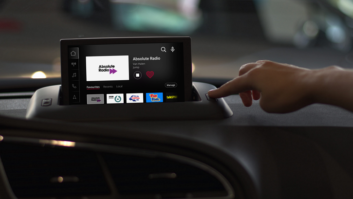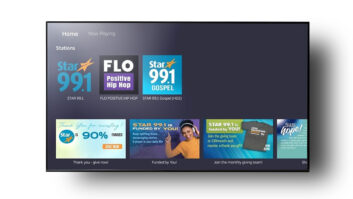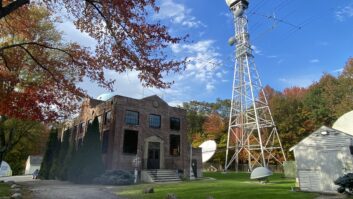
Brian Wilson, Greg Monti and Bob Mack, from left, are shown in front of the rack room at the Cumulus/Westwood One TOC in Purchase, N.Y.PURCHASE, N.Y. — You can’t see it amidst the neat wiring and gleaming surfaces of Cumulus Media Networks/Westwood One’s new network technical operations center north of New York City, but there is plenty of history underlying the facility that’s celebrating its first anniversary.
When Cumulus moved to its new home in an office park in Purchase, Westchester County, it closed out almost 30 years of network operations in ABC’s historic facility at 125 West End Avenue on Manhattan’s Upper West Side. By 2011, a series of ownership changes — first Citadel’s purchase of ABC Radio from Disney and then Cumulus’ acquisition of Citadel — had turned the former ABC Radio technical operations center into the New York hub for Cumulus. The aging plant and Cumulus’ status as a tenant in a Disney/ABC-owned building made relocation a priority.
“It was fairly obvious we needed a new plant that switched audio over IP,” says Bob Mack, vice president of engineering. “What did take a lot of time was figuring out where to build it.”

Master Control Operator Angel Bourdon is in the new Purchase network technical operations center. Even in a city with as much commercial real estate as New York, Mack says it was surprisingly challenging to find space that met all of Cumulus’ specialized needs: access to multiple fiber providers, southern sightlines for satellite reception and 24/7 cooling and power supply. To meet union requirements, the new master control had to be within a 25-mile radius of the old West End Avenue plant.
“A lot of places met most of those objectives, but not all of them,” said Mack, recalling what turned out to be several months of visits to more than 40 buildings scattered through all five boroughs of New York City, northern New Jersey, Long Island and Westchester County. Among their stops, the quest took the team out to the Lodi, N.J., transmitter site of WABC(AM), where Cumulus inherited space that had been used to store and maintain ABC Sports remote trucks — and where field-strength meters showed several volts’ worth of RF field strength from the nearby 50 kW transmitter.
Gary Kline, Cumulus’ vice president of engineering and information technology, sent Mack and Greg Monti, senior VP of operations and engineering, out to examine data centers in hopes of finding the right combination of fiber, cooling and power. That ended up leading to undesirable rent structures — “data centers charge by the watt, not by the square foot,” Monti notes — but it did get the Cumulus team on the right path to the site they needed.
“You want to find the promised land, you follow the fiber,” Mack says. That thread of glass led up to the I-287 corridor across Westchester County, 20 miles north of the city, where multiple fiber providers all converge to link New England to New York City and points beyond.
“We have better connectivity here than we had at West End Avenue,” Monti says of the Purchase location, which is served by six fiber providers.

Look, Ma, (almost) no wires! Each codec connects to the router with a single Cat-6 cable. This is a far cry from the nest of wiring found in the previous NTOC.MOVING ON
Unlike the old ABC space, which put the network master control at the center of a floor filled with studios and the ABC Radio newsroom, Cumulus was able to focus the design of its new 10,000-square-foot facility entirely on distribution. Visitors enter into a hallway alongside a wall of windows looking into the rack room that makes up the heart of the facility. In Manhattan, master control operators worked right in the rack room, scurrying back and forth among the racks to check on incoming feeds, dial up ISDN connections and move patches around in bays. But times have changed: Now that codecs and satellite receivers can all be controlled remotely by IP and patch bays are a thing of the past, Cumulus Corporate Engineer Michael Gay was able to separate the control room from the rack room. Operators in Purchase enjoy outside light from a wall of windows behind them; in front of the Omnirax furniture that fills the control room, another wall of windows looks across a hallway into the rack room.
When it came time to decide how to fill the rack room, one decision was easy: Mack and Monti say there was no question the new facility would continue to use the Harris (now Imagine Communications) automation that had been at the heart of the old Manhattan plant, where it was originally installed under the McCurdy brand name in the 1980s. In Westchester, the Harris Series D automation serves as the ringmaster to control systems that may be more familiar to a typical radio station: Axia’s Livewire audio over IP system transports audio around the plant through a Cisco 4510 router. Netia automation stores and plays out audio, and Telos, Comrex and Harris Intraplex IP and ISDN codecs bring in live audio from the dozens of providers who distribute their programming through this facility. (Instead of trying to get new telco-based ISDN service, which is becoming more challenging, the plant uses T1s through Adtran modules to generate its own ISDN service.)
Behind the racks, Radio Systems’ StudioHub connections tie everything together through 48-jack panels of Cat-6 connections back to the router. “You never have to pull a wire,” Mack boasts of a plant designed so that analog audio never travels more than seven feet before hitting a digital node. Axia’s iPorts extend connectivity to locations outside the building, including Cumulus Media Networks’ production center in Dallas, which can also serve as a backup network TOC in an emergency. Dallas is one of two uplink points; it and the main uplink in nearby Stamford, Conn., are both fed directly by fiber from Purchase. There’s a 750 kVA generator serving the building, and more than six hours of UPS capacity before the generator even needs to kick in.
Brian Wilson, senior director of technical operations, highlighted the capabilities of the AoIP system. For instance, with the ability to switch 200 audio buses, “we need silence sensing,” Wilson says. “You’ve got one guy in master control, and we need to be able to pinpoint where there’s a problem.” In Manhattan, that meant a forest of hardware-based silence sensors all wired back to warning lights in master control. In Purchase, it’s done virtually through Axia, which creates its own software-based silence sensors.
Wilson and the Cumulus team studied the workflow at West End Avenue to determine how to lay out the new master control in Purchase, with an eye toward providing as much control as possible to operators without ever having to leave their desk.

Greg Monti and Bob Mack look at the codecs that deliver programming from outside producers to the Purchase network technical operations center.TOP CREW
It’s an experience Wilson and his management colleagues got to take on firsthand as construction was underway. After the site search wrapped up in the summer of 2012, a year passed while the space was readied for occupancy and equipment was purchased. Cumulus went on a crash course in the summer of 2013 to build out its new plant, bringing in six to eight engineers at a time from local Cumulus stations as far away as Dallas, Houston and Reno to work in shifts alongside vendors and a systems integrator to get everything in place and wired up.
“We had a whole crew of the best and brightest chief engineers Cumulus had to offer,” Mack says. “Everyone was given a plan and told, ‘Do it,’ and that’s when the cardboard started to fly.”
By September of 2013, the first services were beginning to originate from Purchase, but Cumulus needed to continue to staff the Manhattan master control as well. So while the regular master control staff did their jobs in New York, it was up to Mack, Monti and Wilson to keep up a 24/7 rotation among themselves to oversee the new facility in Purchase.
Wilson says it was a valuable experience to be back in the operator’s chair where he’d spent his first 15 years with ABC. “As systems change, there’s nothing like sitting in the seat, answering the phones, to evaluate the workflow.”
INSIDE THE OPERATION
Courtesy of Bob Mack, here are the “main equipment pillars” for the Purchase network technical operations center:
• Process and control automation: Imagine Communications (Harris) D-Series automation
• Audio and GPIO switching: Axia Audio
• Audio content management and storage: Netia
• ASI transport: Evertz
• Satellite Distribution: XDS
• Servers: Dell
• Switches: Cisco
• Backhaul equipment, importing audio and control from other locations: Axia iPort, Telos xStream and Z/IP, Comrex Access, APT Oslo WorldNet IP, Harris IP100, Harris Intraplex, CCS Suprima
Wilson, Monti and Mack spent more than two months on full-time master control duty at Purchase, all while working to move more services from Manhattan to Westchester. By December 2013, the last of Cumulus’ clients had been relocated, the West End Avenue facility was closed down and the master control operators were settling into their new home in Purchase — just in time for another big change.
Its merger with Westwood One means more than just a new sign on the door outside the Purchase NTOC. Inside, the services Westwood One had been offering on its IDC satellite system, including CBS Radio News, were transitioned to the Cumulus XDS system, though the existing Westwood/CBS TOC also remained in place in the CBS Broadcast Center in Manhattan. But, it should be noted, that at the start of 2015, Westwood One will begin distributing Westwood One News, a customized news service powered by CNN, cutting the last of its ties with the ABC network that was once the cornerstone of the operation.
Scott Fybush is a long-time contributor to Radio World.







